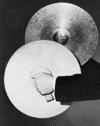- cymbal
-
/sim"beuhl/, n.a concave plate of brass or bronze that produces a sharp, ringing sound when struck: played either in pairs, by being struck together, or singly, by being struck with a drumstick or the like.[bef. 900; ME; OE cymbala < ML, var. of cymbalum < L < Gk kýmbalon, var. of kýmbos, kýmbe hollow object]
* * *
Percussion instrument consisting of a circular metal plate that is struck with a drumstick or two such plates that are struck together.They were used, often ritually, in Assyria, Israel (from с 1100 BC), Egypt, and other ancient civilizations, spread to East Asia, and reached Europe by the 13th century AD. Western orchestral cymbals derive from those used in the Turkish military bands in vogue in 18th-century Europe. Though Asian cymbals are often flat, Middle Eastern and Western cymbals usually have a central concave dome, or boss, so that only the edges touch when they are clashed. The finest cymbals have long been manufactured in Turkey by means of closely guarded techniques. In popular music, cymbals are not clashed manually; instead, a cymbal suspended on a sticklike stand may be brushed or struck, and horizontal "hi-hat" cymbals are clashed lightly by use of a pedal mechanism. Pair of modern hand-held symphonic orchestral cymbalsBy courtesy of Avedis Zildjian Company
Pair of modern hand-held symphonic orchestral cymbalsBy courtesy of Avedis Zildjian Company* * *
percussion instrument consisting of a circular flat or concave metal plate that is struck with a drumstick or is used in pairs struck glancingly together. They were used, often ritually, in Assyria, Israel (from c. 1100 BC), Egypt, and other ancient civilizations and reached East Asia in medieval times and Europe before the 13th century. Most Asian cymbals are either broad-rimmed, with or without a dome (boss), held horizontally, and clashed loudly, or small-rimmed (or rimless), held vertically, and played softly. Western orchestral cymbals derive from those used in the Turkish military bands in vogue in 18th-century Europe (see Janissary music), and cymbals were introduced in work by Joseph Haydn (Haydn, Joseph) (notably his Military Symphony, 1794), Mozart (Mozart, Wolfgang Amadeus), and Beethoven (Beethoven, Ludwig van). In Romantic music—e.g., Richard Wagner's (Wagner, Richard) Tannhäuser—they are frequently used to mark a dramatic climax. Traditionally the best cymbals came from Turkey—their manufacture and copper-tin alloy a guarded secret.Of indefinite pitch, modern cymbals are about 36–46 cm (14–18 inches) in diameter, domed at the centre (where the holding strap is attached), and slightly tapered to secure contact at the edges only. They are capable of a wide dynamic range. Though usually clashed or brushed together, they may also be operated with a foot pedal (as in the hi-hat) and may be brushed or struck in the closed or open position, or a single cymbal may be struck with a brush or a hard- or soft-ended drumstick. From the late 20th century, some composers specified using a bow to sound a cymbal. Additional techniques are used in jazz and dance bands.The “ancient cymbals,” or crotals (crotal) (used, for example, by Claude Debussy (Debussy, Claude) in the 20th century), are small, castanetlike finger cymbals that sound high notes of definite pitch; they have been used in the Middle East since ancient times, primarily as dancers' instruments. Chinese cymbals (bo) are constructed of similar materials to those used in Turkish cymbals, but the outside edges are curved upward and the sound is as a result thinner; small pairs are used in wedding and funeral processions.* * *
Universalium. 2010.
